BSS062-6: Healthcare Management - Integrated Care for Elderly People
VerifiedAdded on 2022/09/27
|14
|3008
|19
Report
AI Summary
This report examines integrated healthcare strategies to improve the quality of life for elderly individuals. It analyzes research findings on integrated care models, highlighting the positive impact on patient outcomes. The report further delves into UK healthcare policies, emphasizing the significance of integrated care in addressing challenges such as multimorbidity and chronic diseases. It explores various care approaches, including Care Homes, Multispecialty Community Providers (MCPs), and Integrated Primary and Acute Care Systems. Additionally, the role of medical informatics and integrated health information systems is discussed, using the Croatian model as an example. The report concludes by underscoring the importance of integrated healthcare in enhancing the well-being of the elderly population and offers insights into the current healthcare landscape.

Running head: Healthcare
Health Care Management
By (Student's Name)
Class
Teacher
Name of the School
City
Date
Health Care Management
By (Student's Name)
Class
Teacher
Name of the School
City
Date
Paraphrase This Document
Need a fresh take? Get an instant paraphrase of this document with our AI Paraphraser
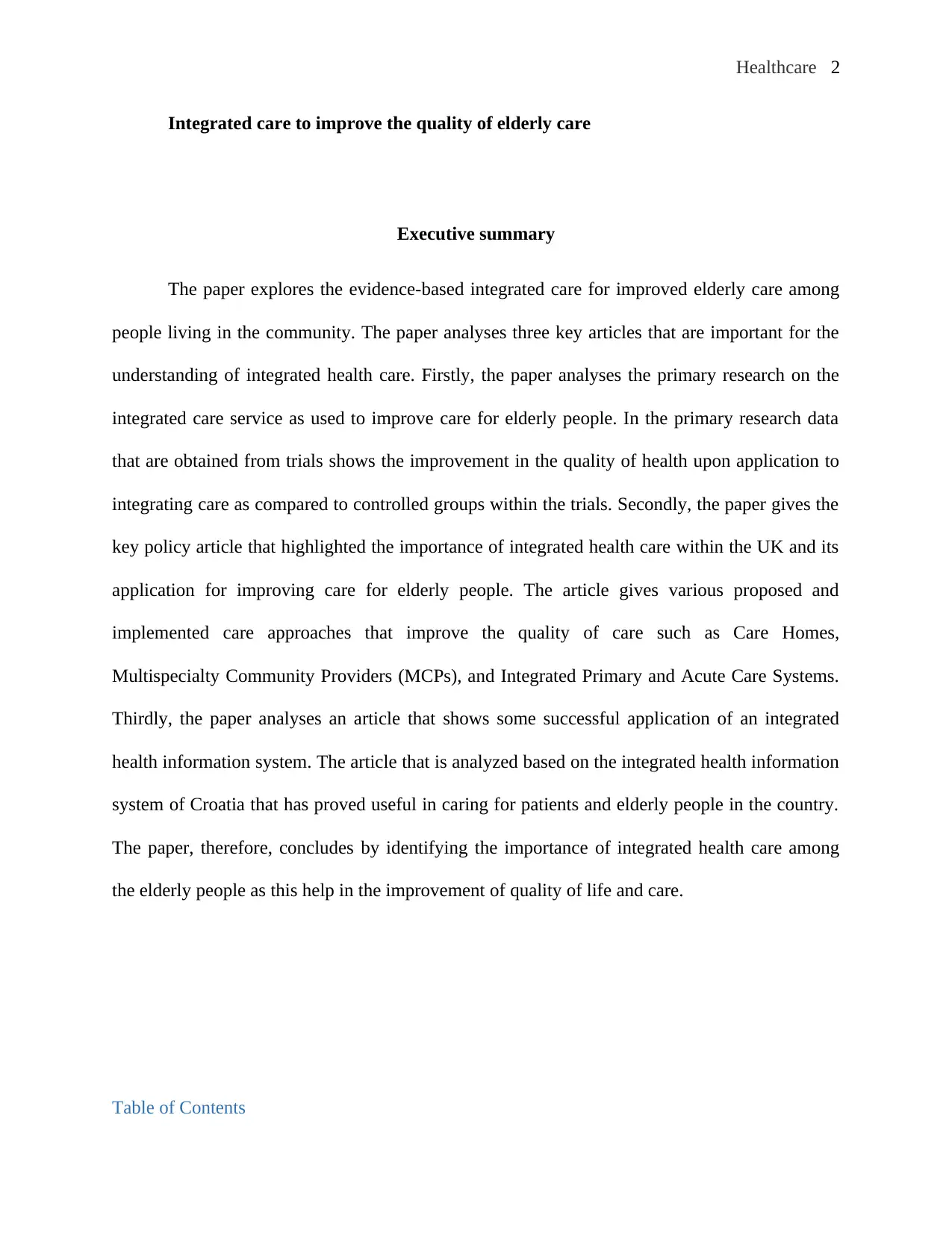
Healthcare 2
Integrated care to improve the quality of elderly care
Executive summary
The paper explores the evidence-based integrated care for improved elderly care among
people living in the community. The paper analyses three key articles that are important for the
understanding of integrated health care. Firstly, the paper analyses the primary research on the
integrated care service as used to improve care for elderly people. In the primary research data
that are obtained from trials shows the improvement in the quality of health upon application to
integrating care as compared to controlled groups within the trials. Secondly, the paper gives the
key policy article that highlighted the importance of integrated health care within the UK and its
application for improving care for elderly people. The article gives various proposed and
implemented care approaches that improve the quality of care such as Care Homes,
Multispecialty Community Providers (MCPs), and Integrated Primary and Acute Care Systems.
Thirdly, the paper analyses an article that shows some successful application of an integrated
health information system. The article that is analyzed based on the integrated health information
system of Croatia that has proved useful in caring for patients and elderly people in the country.
The paper, therefore, concludes by identifying the importance of integrated health care among
the elderly people as this help in the improvement of quality of life and care.
Table of Contents
Integrated care to improve the quality of elderly care
Executive summary
The paper explores the evidence-based integrated care for improved elderly care among
people living in the community. The paper analyses three key articles that are important for the
understanding of integrated health care. Firstly, the paper analyses the primary research on the
integrated care service as used to improve care for elderly people. In the primary research data
that are obtained from trials shows the improvement in the quality of health upon application to
integrating care as compared to controlled groups within the trials. Secondly, the paper gives the
key policy article that highlighted the importance of integrated health care within the UK and its
application for improving care for elderly people. The article gives various proposed and
implemented care approaches that improve the quality of care such as Care Homes,
Multispecialty Community Providers (MCPs), and Integrated Primary and Acute Care Systems.
Thirdly, the paper analyses an article that shows some successful application of an integrated
health information system. The article that is analyzed based on the integrated health information
system of Croatia that has proved useful in caring for patients and elderly people in the country.
The paper, therefore, concludes by identifying the importance of integrated health care among
the elderly people as this help in the improvement of quality of life and care.
Table of Contents
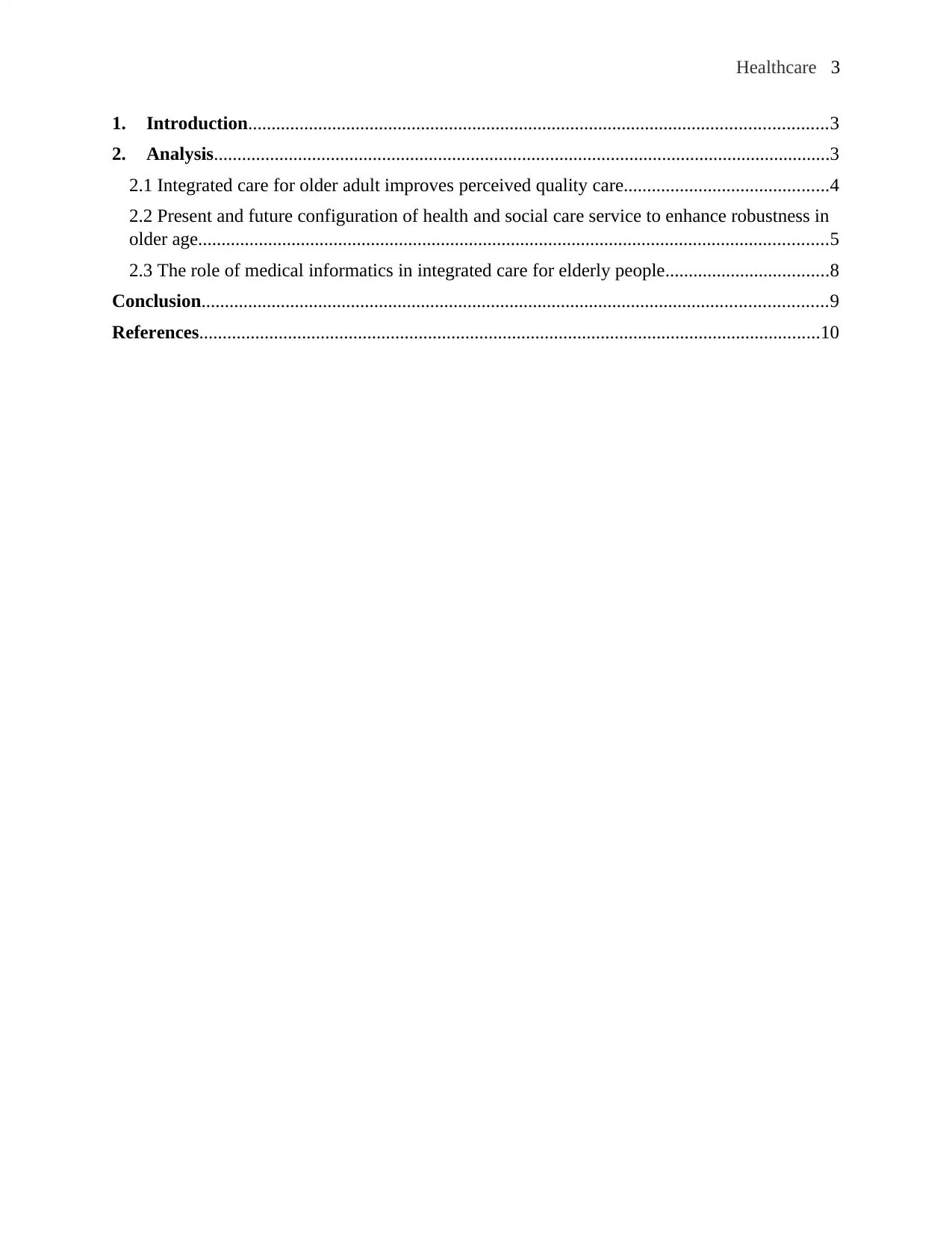
Healthcare 3
1. Introduction............................................................................................................................3
2. Analysis....................................................................................................................................3
2.1 Integrated care for older adult improves perceived quality care............................................4
2.2 Present and future configuration of health and social care service to enhance robustness in
older age.......................................................................................................................................5
2.3 The role of medical informatics in integrated care for elderly people...................................8
Conclusion......................................................................................................................................9
References.....................................................................................................................................10
1. Introduction............................................................................................................................3
2. Analysis....................................................................................................................................3
2.1 Integrated care for older adult improves perceived quality care............................................4
2.2 Present and future configuration of health and social care service to enhance robustness in
older age.......................................................................................................................................5
2.3 The role of medical informatics in integrated care for elderly people...................................8
Conclusion......................................................................................................................................9
References.....................................................................................................................................10
⊘ This is a preview!⊘
Do you want full access?
Subscribe today to unlock all pages.

Trusted by 1+ million students worldwide
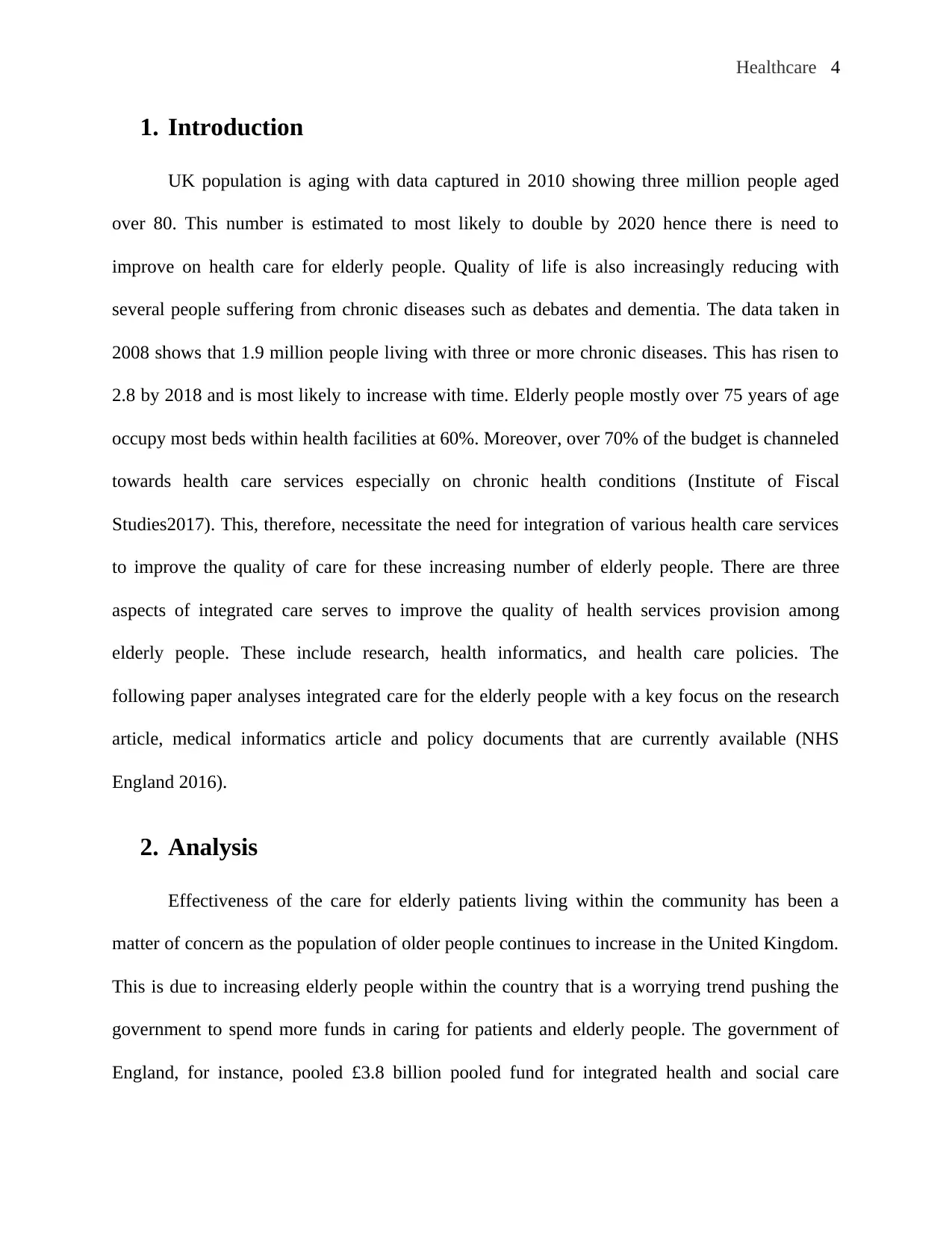
Healthcare 4
1. Introduction
UK population is aging with data captured in 2010 showing three million people aged
over 80. This number is estimated to most likely to double by 2020 hence there is need to
improve on health care for elderly people. Quality of life is also increasingly reducing with
several people suffering from chronic diseases such as debates and dementia. The data taken in
2008 shows that 1.9 million people living with three or more chronic diseases. This has risen to
2.8 by 2018 and is most likely to increase with time. Elderly people mostly over 75 years of age
occupy most beds within health facilities at 60%. Moreover, over 70% of the budget is channeled
towards health care services especially on chronic health conditions (Institute of Fiscal
Studies2017). This, therefore, necessitate the need for integration of various health care services
to improve the quality of care for these increasing number of elderly people. There are three
aspects of integrated care serves to improve the quality of health services provision among
elderly people. These include research, health informatics, and health care policies. The
following paper analyses integrated care for the elderly people with a key focus on the research
article, medical informatics article and policy documents that are currently available (NHS
England 2016).
2. Analysis
Effectiveness of the care for elderly patients living within the community has been a
matter of concern as the population of older people continues to increase in the United Kingdom.
This is due to increasing elderly people within the country that is a worrying trend pushing the
government to spend more funds in caring for patients and elderly people. The government of
England, for instance, pooled £3.8 billion pooled fund for integrated health and social care
1. Introduction
UK population is aging with data captured in 2010 showing three million people aged
over 80. This number is estimated to most likely to double by 2020 hence there is need to
improve on health care for elderly people. Quality of life is also increasingly reducing with
several people suffering from chronic diseases such as debates and dementia. The data taken in
2008 shows that 1.9 million people living with three or more chronic diseases. This has risen to
2.8 by 2018 and is most likely to increase with time. Elderly people mostly over 75 years of age
occupy most beds within health facilities at 60%. Moreover, over 70% of the budget is channeled
towards health care services especially on chronic health conditions (Institute of Fiscal
Studies2017). This, therefore, necessitate the need for integration of various health care services
to improve the quality of care for these increasing number of elderly people. There are three
aspects of integrated care serves to improve the quality of health services provision among
elderly people. These include research, health informatics, and health care policies. The
following paper analyses integrated care for the elderly people with a key focus on the research
article, medical informatics article and policy documents that are currently available (NHS
England 2016).
2. Analysis
Effectiveness of the care for elderly patients living within the community has been a
matter of concern as the population of older people continues to increase in the United Kingdom.
This is due to increasing elderly people within the country that is a worrying trend pushing the
government to spend more funds in caring for patients and elderly people. The government of
England, for instance, pooled £3.8 billion pooled fund for integrated health and social care
Paraphrase This Document
Need a fresh take? Get an instant paraphrase of this document with our AI Paraphraser
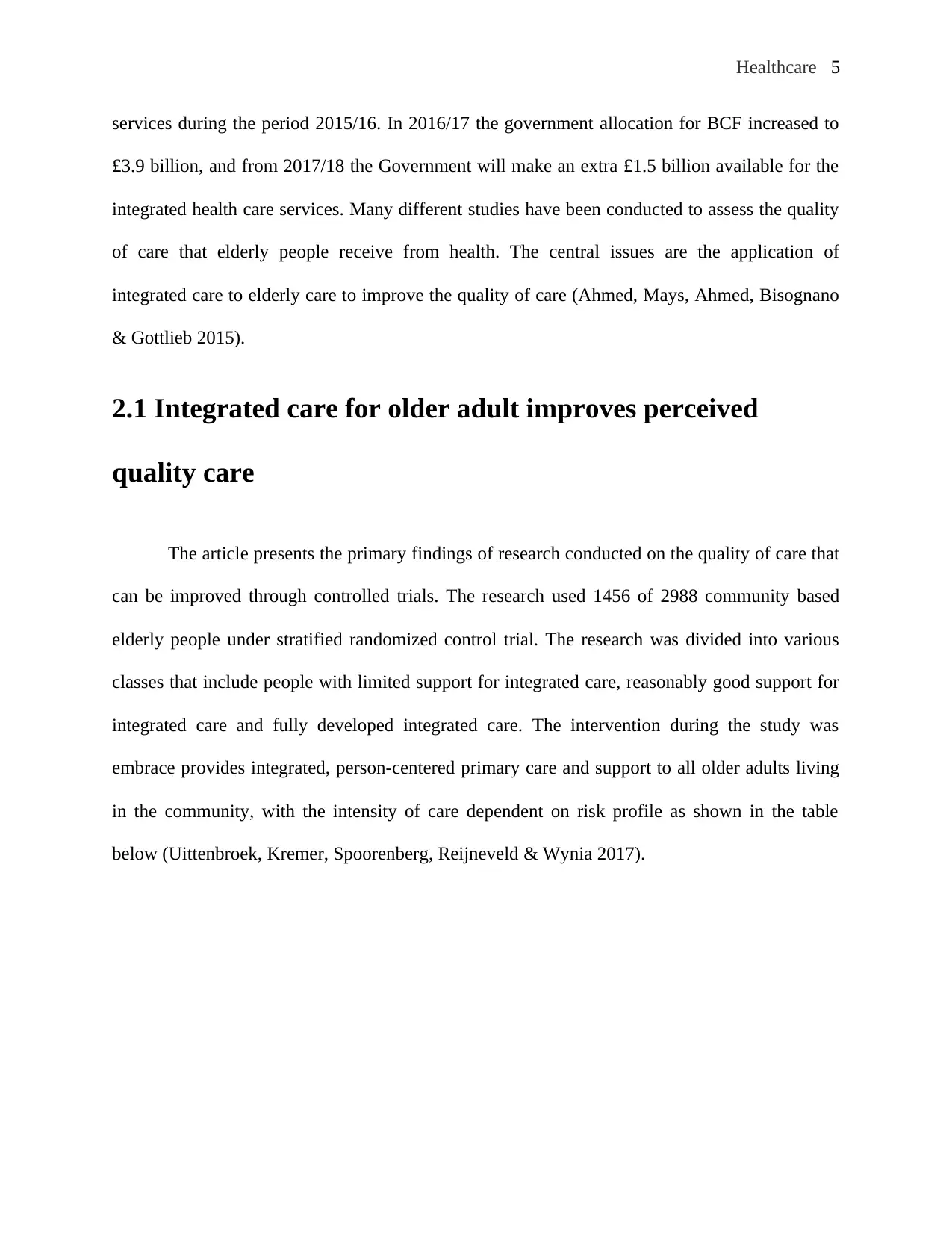
Healthcare 5
services during the period 2015/16. In 2016/17 the government allocation for BCF increased to
£3.9 billion, and from 2017/18 the Government will make an extra £1.5 billion available for the
integrated health care services. Many different studies have been conducted to assess the quality
of care that elderly people receive from health. The central issues are the application of
integrated care to elderly care to improve the quality of care (Ahmed, Mays, Ahmed, Bisognano
& Gottlieb 2015).
2.1 Integrated care for older adult improves perceived
quality care
The article presents the primary findings of research conducted on the quality of care that
can be improved through controlled trials. The research used 1456 of 2988 community based
elderly people under stratified randomized control trial. The research was divided into various
classes that include people with limited support for integrated care, reasonably good support for
integrated care and fully developed integrated care. The intervention during the study was
embrace provides integrated, person-centered primary care and support to all older adults living
in the community, with the intensity of care dependent on risk profile as shown in the table
below (Uittenbroek, Kremer, Spoorenberg, Reijneveld & Wynia 2017).
services during the period 2015/16. In 2016/17 the government allocation for BCF increased to
£3.9 billion, and from 2017/18 the Government will make an extra £1.5 billion available for the
integrated health care services. Many different studies have been conducted to assess the quality
of care that elderly people receive from health. The central issues are the application of
integrated care to elderly care to improve the quality of care (Ahmed, Mays, Ahmed, Bisognano
& Gottlieb 2015).
2.1 Integrated care for older adult improves perceived
quality care
The article presents the primary findings of research conducted on the quality of care that
can be improved through controlled trials. The research used 1456 of 2988 community based
elderly people under stratified randomized control trial. The research was divided into various
classes that include people with limited support for integrated care, reasonably good support for
integrated care and fully developed integrated care. The intervention during the study was
embrace provides integrated, person-centered primary care and support to all older adults living
in the community, with the intensity of care dependent on risk profile as shown in the table
below (Uittenbroek, Kremer, Spoorenberg, Reijneveld & Wynia 2017).
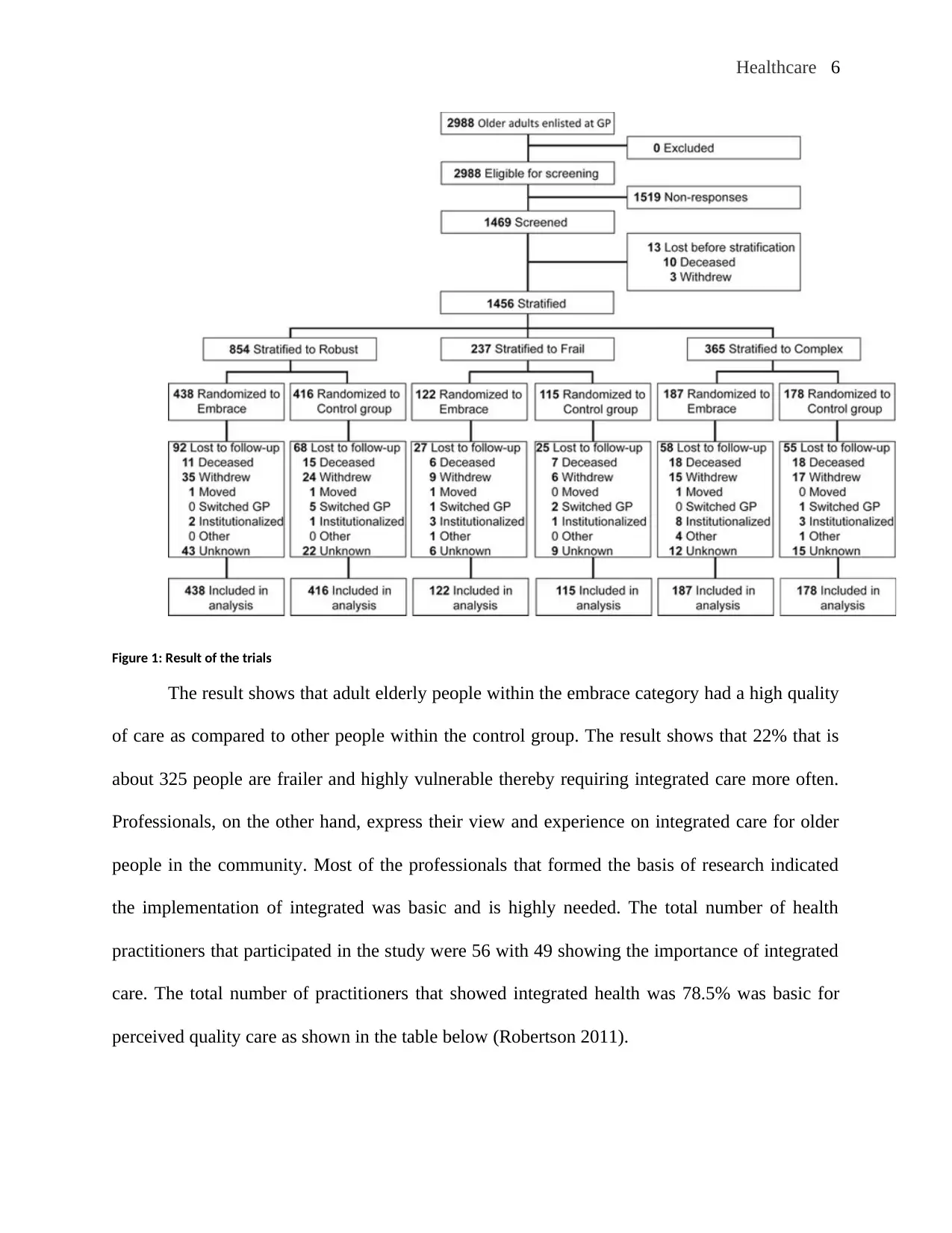
Healthcare 6
Figure 1: Result of the trials
The result shows that adult elderly people within the embrace category had a high quality
of care as compared to other people within the control group. The result shows that 22% that is
about 325 people are frailer and highly vulnerable thereby requiring integrated care more often.
Professionals, on the other hand, express their view and experience on integrated care for older
people in the community. Most of the professionals that formed the basis of research indicated
the implementation of integrated was basic and is highly needed. The total number of health
practitioners that participated in the study were 56 with 49 showing the importance of integrated
care. The total number of practitioners that showed integrated health was 78.5% was basic for
perceived quality care as shown in the table below (Robertson 2011).
Figure 1: Result of the trials
The result shows that adult elderly people within the embrace category had a high quality
of care as compared to other people within the control group. The result shows that 22% that is
about 325 people are frailer and highly vulnerable thereby requiring integrated care more often.
Professionals, on the other hand, express their view and experience on integrated care for older
people in the community. Most of the professionals that formed the basis of research indicated
the implementation of integrated was basic and is highly needed. The total number of health
practitioners that participated in the study were 56 with 49 showing the importance of integrated
care. The total number of practitioners that showed integrated health was 78.5% was basic for
perceived quality care as shown in the table below (Robertson 2011).
⊘ This is a preview!⊘
Do you want full access?
Subscribe today to unlock all pages.

Trusted by 1+ million students worldwide
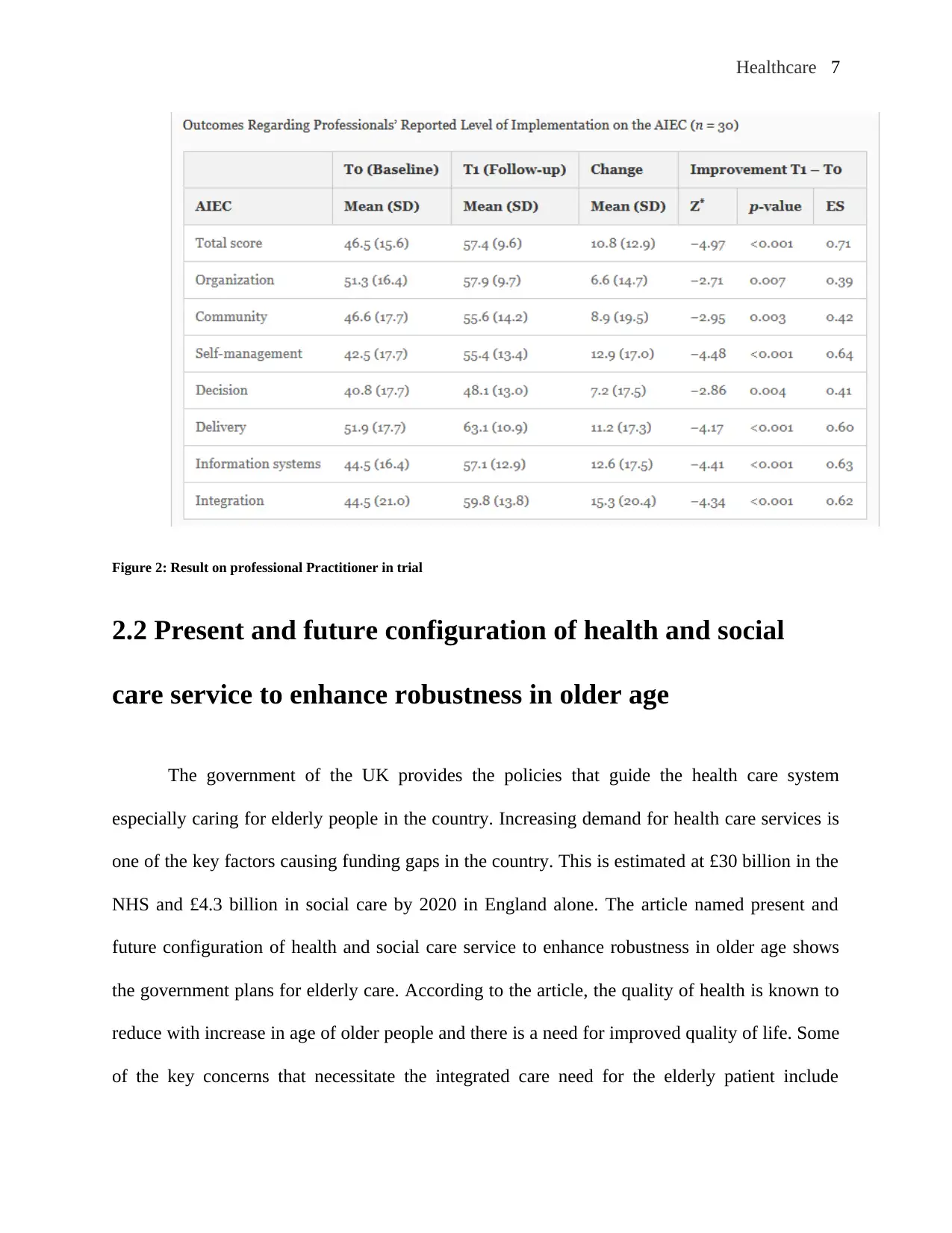
Healthcare 7
Figure 2: Result on professional Practitioner in trial
2.2 Present and future configuration of health and social
care service to enhance robustness in older age
The government of the UK provides the policies that guide the health care system
especially caring for elderly people in the country. Increasing demand for health care services is
one of the key factors causing funding gaps in the country. This is estimated at £30 billion in the
NHS and £4.3 billion in social care by 2020 in England alone. The article named present and
future configuration of health and social care service to enhance robustness in older age shows
the government plans for elderly care. According to the article, the quality of health is known to
reduce with increase in age of older people and there is a need for improved quality of life. Some
of the key concerns that necessitate the integrated care need for the elderly patient include
Figure 2: Result on professional Practitioner in trial
2.2 Present and future configuration of health and social
care service to enhance robustness in older age
The government of the UK provides the policies that guide the health care system
especially caring for elderly people in the country. Increasing demand for health care services is
one of the key factors causing funding gaps in the country. This is estimated at £30 billion in the
NHS and £4.3 billion in social care by 2020 in England alone. The article named present and
future configuration of health and social care service to enhance robustness in older age shows
the government plans for elderly care. According to the article, the quality of health is known to
reduce with increase in age of older people and there is a need for improved quality of life. Some
of the key concerns that necessitate the integrated care need for the elderly patient include
Paraphrase This Document
Need a fresh take? Get an instant paraphrase of this document with our AI Paraphraser
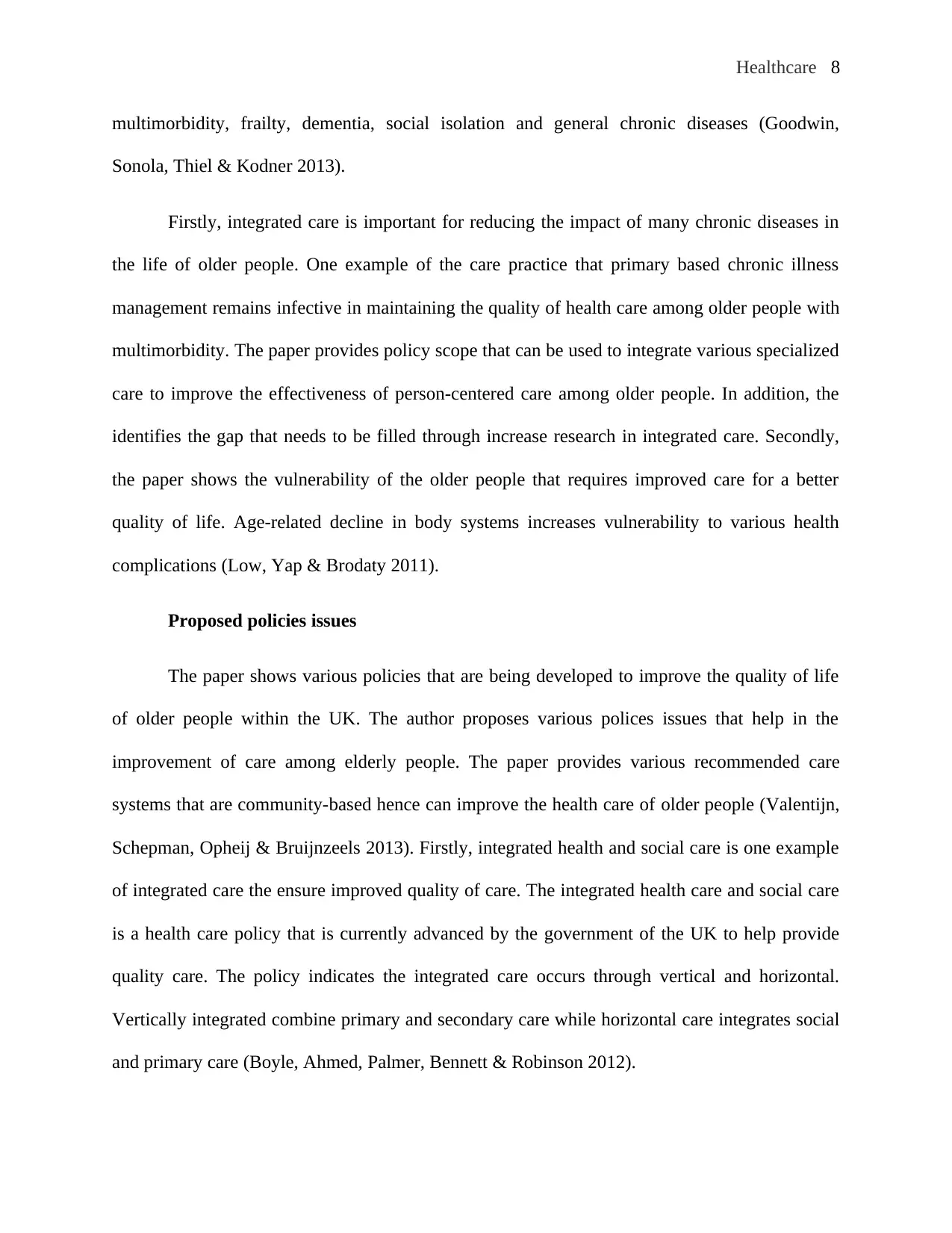
Healthcare 8
multimorbidity, frailty, dementia, social isolation and general chronic diseases (Goodwin,
Sonola, Thiel & Kodner 2013).
Firstly, integrated care is important for reducing the impact of many chronic diseases in
the life of older people. One example of the care practice that primary based chronic illness
management remains infective in maintaining the quality of health care among older people with
multimorbidity. The paper provides policy scope that can be used to integrate various specialized
care to improve the effectiveness of person-centered care among older people. In addition, the
identifies the gap that needs to be filled through increase research in integrated care. Secondly,
the paper shows the vulnerability of the older people that requires improved care for a better
quality of life. Age-related decline in body systems increases vulnerability to various health
complications (Low, Yap & Brodaty 2011).
Proposed policies issues
The paper shows various policies that are being developed to improve the quality of life
of older people within the UK. The author proposes various polices issues that help in the
improvement of care among elderly people. The paper provides various recommended care
systems that are community-based hence can improve the health care of older people (Valentijn,
Schepman, Opheij & Bruijnzeels 2013). Firstly, integrated health and social care is one example
of integrated care the ensure improved quality of care. The integrated health care and social care
is a health care policy that is currently advanced by the government of the UK to help provide
quality care. The policy indicates the integrated care occurs through vertical and horizontal.
Vertically integrated combine primary and secondary care while horizontal care integrates social
and primary care (Boyle, Ahmed, Palmer, Bennett & Robinson 2012).
multimorbidity, frailty, dementia, social isolation and general chronic diseases (Goodwin,
Sonola, Thiel & Kodner 2013).
Firstly, integrated care is important for reducing the impact of many chronic diseases in
the life of older people. One example of the care practice that primary based chronic illness
management remains infective in maintaining the quality of health care among older people with
multimorbidity. The paper provides policy scope that can be used to integrate various specialized
care to improve the effectiveness of person-centered care among older people. In addition, the
identifies the gap that needs to be filled through increase research in integrated care. Secondly,
the paper shows the vulnerability of the older people that requires improved care for a better
quality of life. Age-related decline in body systems increases vulnerability to various health
complications (Low, Yap & Brodaty 2011).
Proposed policies issues
The paper shows various policies that are being developed to improve the quality of life
of older people within the UK. The author proposes various polices issues that help in the
improvement of care among elderly people. The paper provides various recommended care
systems that are community-based hence can improve the health care of older people (Valentijn,
Schepman, Opheij & Bruijnzeels 2013). Firstly, integrated health and social care is one example
of integrated care the ensure improved quality of care. The integrated health care and social care
is a health care policy that is currently advanced by the government of the UK to help provide
quality care. The policy indicates the integrated care occurs through vertical and horizontal.
Vertically integrated combine primary and secondary care while horizontal care integrates social
and primary care (Boyle, Ahmed, Palmer, Bennett & Robinson 2012).
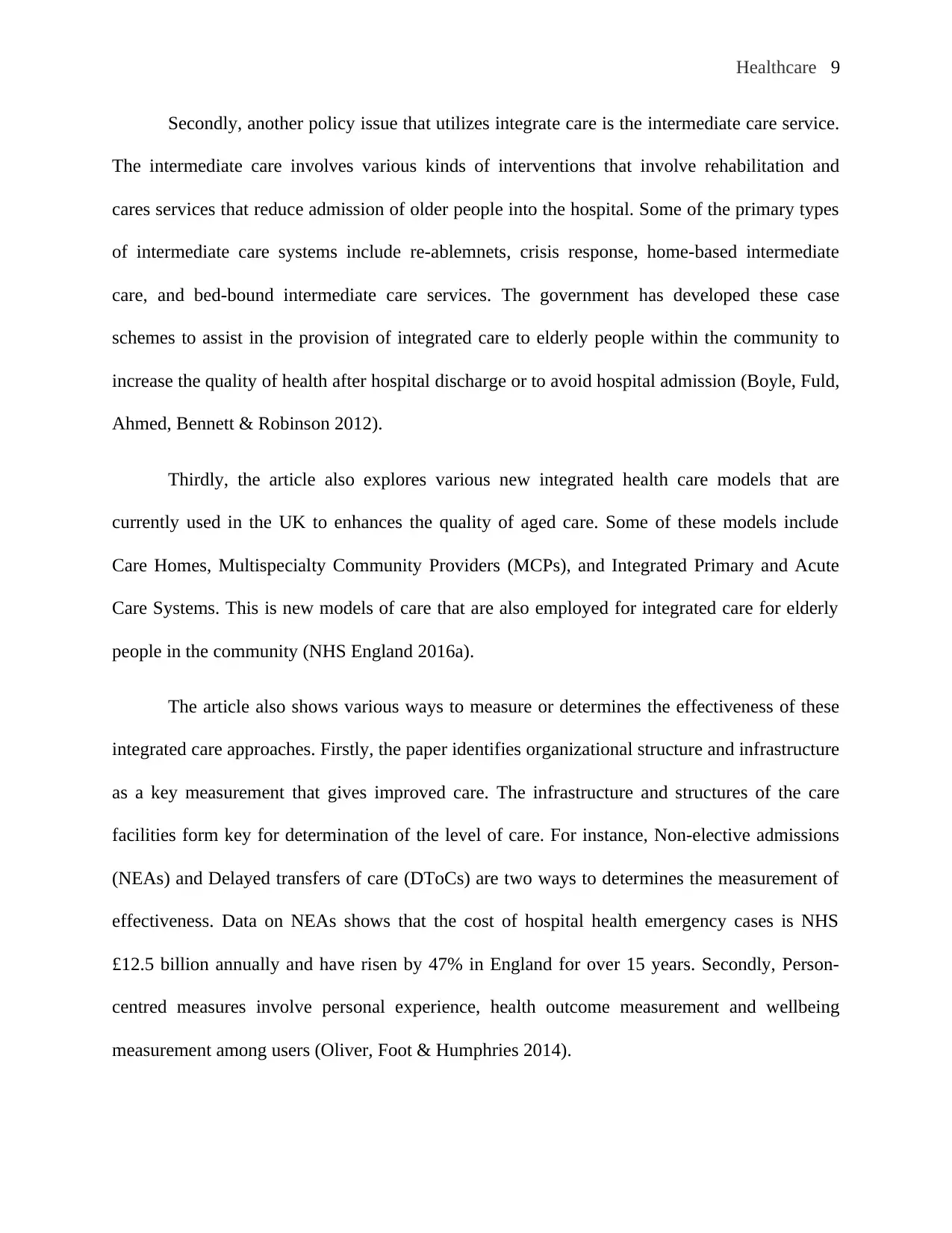
Healthcare 9
Secondly, another policy issue that utilizes integrate care is the intermediate care service.
The intermediate care involves various kinds of interventions that involve rehabilitation and
cares services that reduce admission of older people into the hospital. Some of the primary types
of intermediate care systems include re-ablemnets, crisis response, home-based intermediate
care, and bed-bound intermediate care services. The government has developed these case
schemes to assist in the provision of integrated care to elderly people within the community to
increase the quality of health after hospital discharge or to avoid hospital admission (Boyle, Fuld,
Ahmed, Bennett & Robinson 2012).
Thirdly, the article also explores various new integrated health care models that are
currently used in the UK to enhances the quality of aged care. Some of these models include
Care Homes, Multispecialty Community Providers (MCPs), and Integrated Primary and Acute
Care Systems. This is new models of care that are also employed for integrated care for elderly
people in the community (NHS England 2016a).
The article also shows various ways to measure or determines the effectiveness of these
integrated care approaches. Firstly, the paper identifies organizational structure and infrastructure
as a key measurement that gives improved care. The infrastructure and structures of the care
facilities form key for determination of the level of care. For instance, Non-elective admissions
(NEAs) and Delayed transfers of care (DToCs) are two ways to determines the measurement of
effectiveness. Data on NEAs shows that the cost of hospital health emergency cases is NHS
£12.5 billion annually and have risen by 47% in England for over 15 years. Secondly, Person-
centred measures involve personal experience, health outcome measurement and wellbeing
measurement among users (Oliver, Foot & Humphries 2014).
Secondly, another policy issue that utilizes integrate care is the intermediate care service.
The intermediate care involves various kinds of interventions that involve rehabilitation and
cares services that reduce admission of older people into the hospital. Some of the primary types
of intermediate care systems include re-ablemnets, crisis response, home-based intermediate
care, and bed-bound intermediate care services. The government has developed these case
schemes to assist in the provision of integrated care to elderly people within the community to
increase the quality of health after hospital discharge or to avoid hospital admission (Boyle, Fuld,
Ahmed, Bennett & Robinson 2012).
Thirdly, the article also explores various new integrated health care models that are
currently used in the UK to enhances the quality of aged care. Some of these models include
Care Homes, Multispecialty Community Providers (MCPs), and Integrated Primary and Acute
Care Systems. This is new models of care that are also employed for integrated care for elderly
people in the community (NHS England 2016a).
The article also shows various ways to measure or determines the effectiveness of these
integrated care approaches. Firstly, the paper identifies organizational structure and infrastructure
as a key measurement that gives improved care. The infrastructure and structures of the care
facilities form key for determination of the level of care. For instance, Non-elective admissions
(NEAs) and Delayed transfers of care (DToCs) are two ways to determines the measurement of
effectiveness. Data on NEAs shows that the cost of hospital health emergency cases is NHS
£12.5 billion annually and have risen by 47% in England for over 15 years. Secondly, Person-
centred measures involve personal experience, health outcome measurement and wellbeing
measurement among users (Oliver, Foot & Humphries 2014).
⊘ This is a preview!⊘
Do you want full access?
Subscribe today to unlock all pages.

Trusted by 1+ million students worldwide
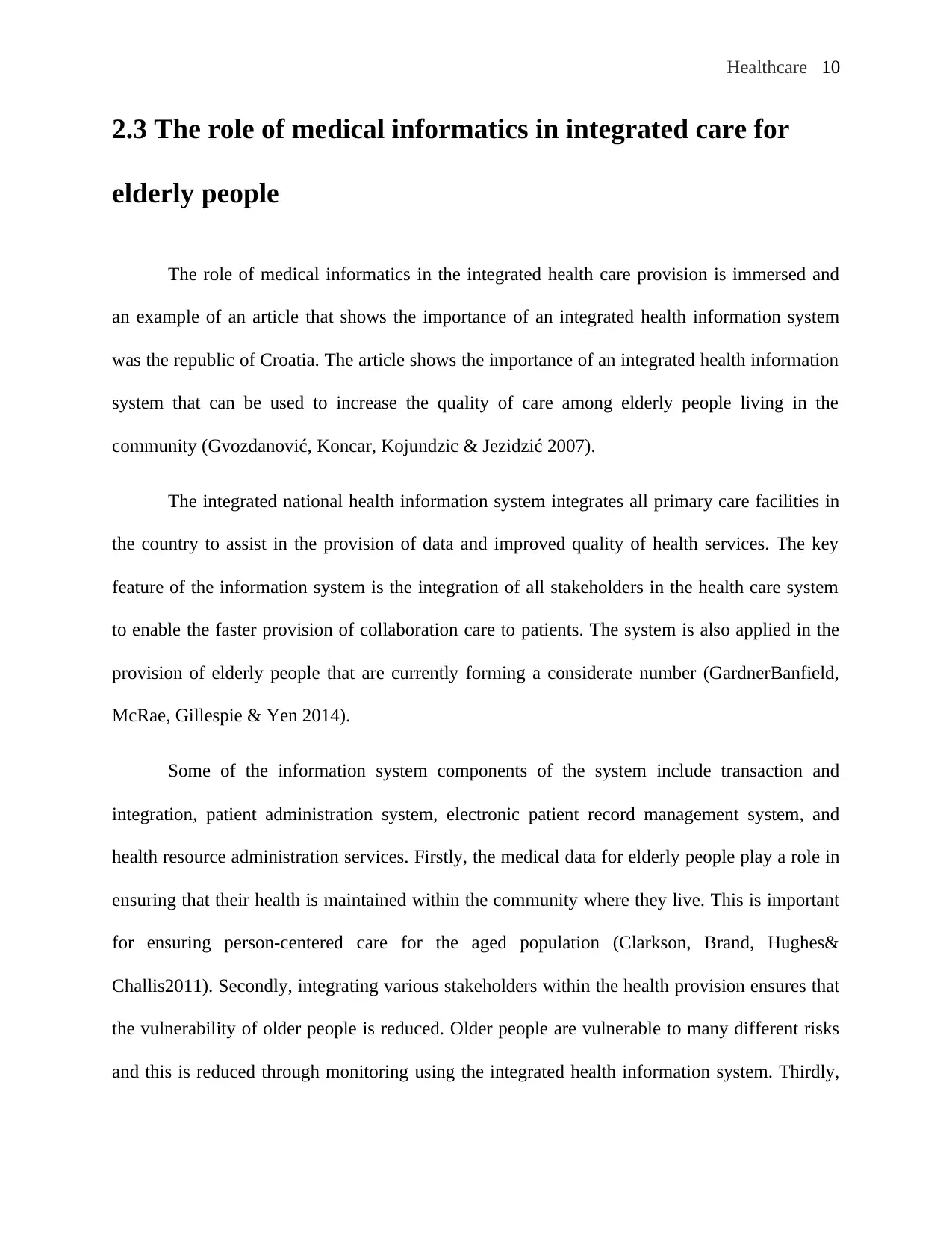
Healthcare 10
2.3 The role of medical informatics in integrated care for
elderly people
The role of medical informatics in the integrated health care provision is immersed and
an example of an article that shows the importance of an integrated health information system
was the republic of Croatia. The article shows the importance of an integrated health information
system that can be used to increase the quality of care among elderly people living in the
community (Gvozdanović, Koncar, Kojundzic & Jezidzić 2007).
The integrated national health information system integrates all primary care facilities in
the country to assist in the provision of data and improved quality of health services. The key
feature of the information system is the integration of all stakeholders in the health care system
to enable the faster provision of collaboration care to patients. The system is also applied in the
provision of elderly people that are currently forming a considerate number (GardnerBanfield,
McRae, Gillespie & Yen 2014).
Some of the information system components of the system include transaction and
integration, patient administration system, electronic patient record management system, and
health resource administration services. Firstly, the medical data for elderly people play a role in
ensuring that their health is maintained within the community where they live. This is important
for ensuring person-centered care for the aged population (Clarkson, Brand, Hughes&
Challis2011). Secondly, integrating various stakeholders within the health provision ensures that
the vulnerability of older people is reduced. Older people are vulnerable to many different risks
and this is reduced through monitoring using the integrated health information system. Thirdly,
2.3 The role of medical informatics in integrated care for
elderly people
The role of medical informatics in the integrated health care provision is immersed and
an example of an article that shows the importance of an integrated health information system
was the republic of Croatia. The article shows the importance of an integrated health information
system that can be used to increase the quality of care among elderly people living in the
community (Gvozdanović, Koncar, Kojundzic & Jezidzić 2007).
The integrated national health information system integrates all primary care facilities in
the country to assist in the provision of data and improved quality of health services. The key
feature of the information system is the integration of all stakeholders in the health care system
to enable the faster provision of collaboration care to patients. The system is also applied in the
provision of elderly people that are currently forming a considerate number (GardnerBanfield,
McRae, Gillespie & Yen 2014).
Some of the information system components of the system include transaction and
integration, patient administration system, electronic patient record management system, and
health resource administration services. Firstly, the medical data for elderly people play a role in
ensuring that their health is maintained within the community where they live. This is important
for ensuring person-centered care for the aged population (Clarkson, Brand, Hughes&
Challis2011). Secondly, integrating various stakeholders within the health provision ensures that
the vulnerability of older people is reduced. Older people are vulnerable to many different risks
and this is reduced through monitoring using the integrated health information system. Thirdly,
Paraphrase This Document
Need a fresh take? Get an instant paraphrase of this document with our AI Paraphraser
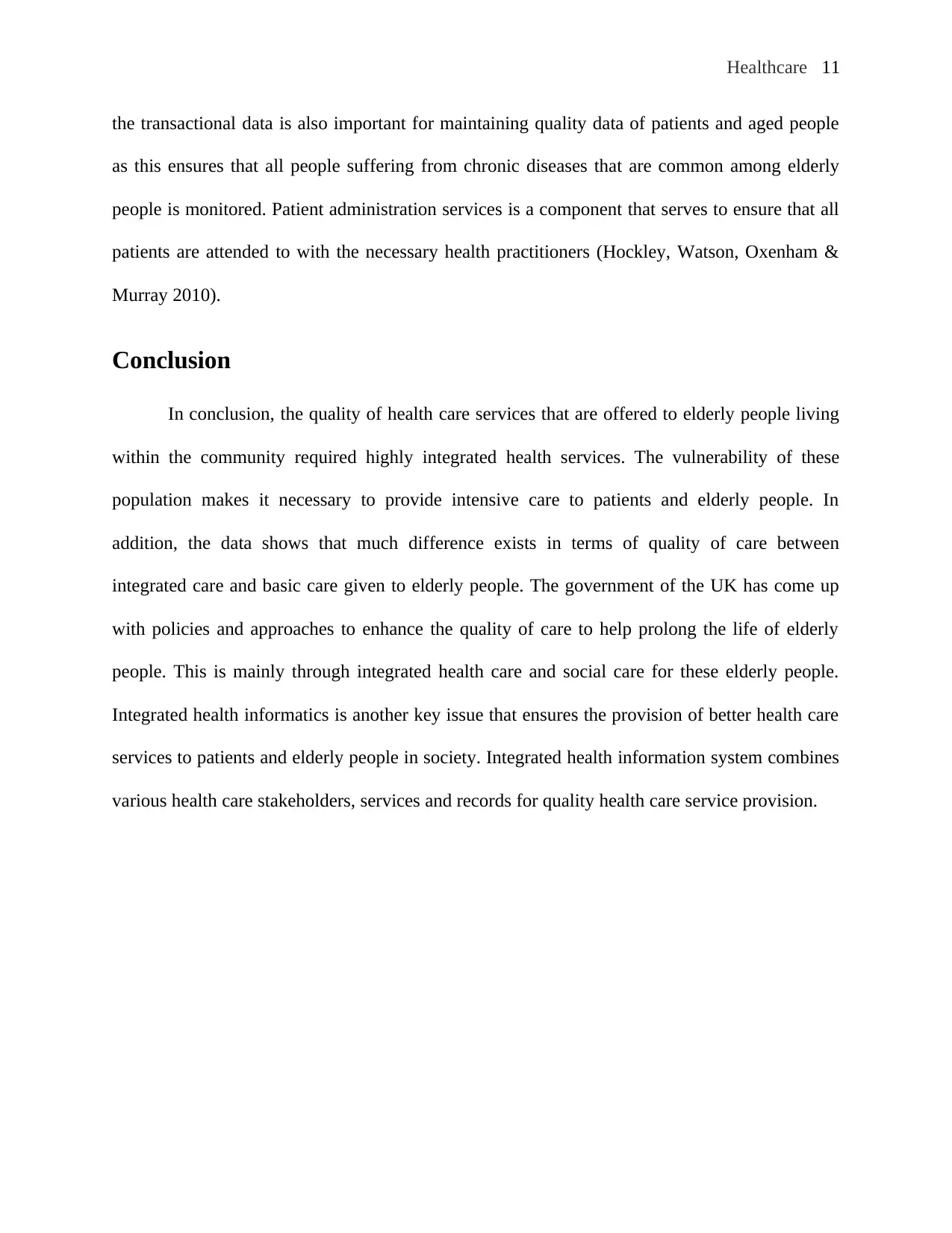
Healthcare 11
the transactional data is also important for maintaining quality data of patients and aged people
as this ensures that all people suffering from chronic diseases that are common among elderly
people is monitored. Patient administration services is a component that serves to ensure that all
patients are attended to with the necessary health practitioners (Hockley, Watson, Oxenham &
Murray 2010).
Conclusion
In conclusion, the quality of health care services that are offered to elderly people living
within the community required highly integrated health services. The vulnerability of these
population makes it necessary to provide intensive care to patients and elderly people. In
addition, the data shows that much difference exists in terms of quality of care between
integrated care and basic care given to elderly people. The government of the UK has come up
with policies and approaches to enhance the quality of care to help prolong the life of elderly
people. This is mainly through integrated health care and social care for these elderly people.
Integrated health informatics is another key issue that ensures the provision of better health care
services to patients and elderly people in society. Integrated health information system combines
various health care stakeholders, services and records for quality health care service provision.
the transactional data is also important for maintaining quality data of patients and aged people
as this ensures that all people suffering from chronic diseases that are common among elderly
people is monitored. Patient administration services is a component that serves to ensure that all
patients are attended to with the necessary health practitioners (Hockley, Watson, Oxenham &
Murray 2010).
Conclusion
In conclusion, the quality of health care services that are offered to elderly people living
within the community required highly integrated health services. The vulnerability of these
population makes it necessary to provide intensive care to patients and elderly people. In
addition, the data shows that much difference exists in terms of quality of care between
integrated care and basic care given to elderly people. The government of the UK has come up
with policies and approaches to enhance the quality of care to help prolong the life of elderly
people. This is mainly through integrated health care and social care for these elderly people.
Integrated health informatics is another key issue that ensures the provision of better health care
services to patients and elderly people in society. Integrated health information system combines
various health care stakeholders, services and records for quality health care service provision.
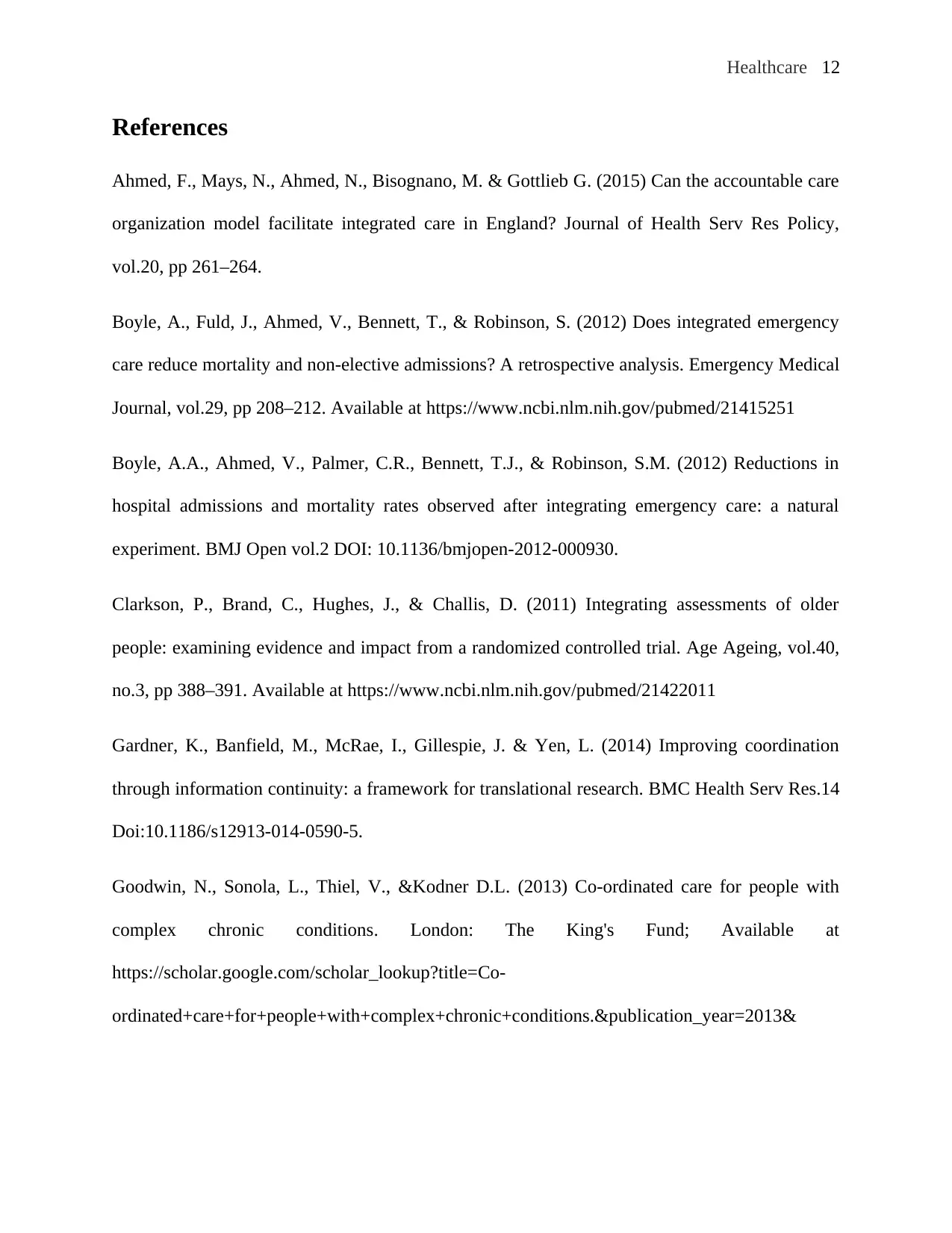
Healthcare 12
References
Ahmed, F., Mays, N., Ahmed, N., Bisognano, M. & Gottlieb G. (2015) Can the accountable care
organization model facilitate integrated care in England? Journal of Health Serv Res Policy,
vol.20, pp 261–264.
Boyle, A., Fuld, J., Ahmed, V., Bennett, T., & Robinson, S. (2012) Does integrated emergency
care reduce mortality and non-elective admissions? A retrospective analysis. Emergency Medical
Journal, vol.29, pp 208–212. Available at https://www.ncbi.nlm.nih.gov/pubmed/21415251
Boyle, A.A., Ahmed, V., Palmer, C.R., Bennett, T.J., & Robinson, S.M. (2012) Reductions in
hospital admissions and mortality rates observed after integrating emergency care: a natural
experiment. BMJ Open vol.2 DOI: 10.1136/bmjopen-2012-000930.
Clarkson, P., Brand, C., Hughes, J., & Challis, D. (2011) Integrating assessments of older
people: examining evidence and impact from a randomized controlled trial. Age Ageing, vol.40,
no.3, pp 388–391. Available at https://www.ncbi.nlm.nih.gov/pubmed/21422011
Gardner, K., Banfield, M., McRae, I., Gillespie, J. & Yen, L. (2014) Improving coordination
through information continuity: a framework for translational research. BMC Health Serv Res.14
Doi:10.1186/s12913-014-0590-5.
Goodwin, N., Sonola, L., Thiel, V., &Kodner D.L. (2013) Co-ordinated care for people with
complex chronic conditions. London: The King's Fund; Available at
https://scholar.google.com/scholar_lookup?title=Co-
ordinated+care+for+people+with+complex+chronic+conditions.&publication_year=2013&
References
Ahmed, F., Mays, N., Ahmed, N., Bisognano, M. & Gottlieb G. (2015) Can the accountable care
organization model facilitate integrated care in England? Journal of Health Serv Res Policy,
vol.20, pp 261–264.
Boyle, A., Fuld, J., Ahmed, V., Bennett, T., & Robinson, S. (2012) Does integrated emergency
care reduce mortality and non-elective admissions? A retrospective analysis. Emergency Medical
Journal, vol.29, pp 208–212. Available at https://www.ncbi.nlm.nih.gov/pubmed/21415251
Boyle, A.A., Ahmed, V., Palmer, C.R., Bennett, T.J., & Robinson, S.M. (2012) Reductions in
hospital admissions and mortality rates observed after integrating emergency care: a natural
experiment. BMJ Open vol.2 DOI: 10.1136/bmjopen-2012-000930.
Clarkson, P., Brand, C., Hughes, J., & Challis, D. (2011) Integrating assessments of older
people: examining evidence and impact from a randomized controlled trial. Age Ageing, vol.40,
no.3, pp 388–391. Available at https://www.ncbi.nlm.nih.gov/pubmed/21422011
Gardner, K., Banfield, M., McRae, I., Gillespie, J. & Yen, L. (2014) Improving coordination
through information continuity: a framework for translational research. BMC Health Serv Res.14
Doi:10.1186/s12913-014-0590-5.
Goodwin, N., Sonola, L., Thiel, V., &Kodner D.L. (2013) Co-ordinated care for people with
complex chronic conditions. London: The King's Fund; Available at
https://scholar.google.com/scholar_lookup?title=Co-
ordinated+care+for+people+with+complex+chronic+conditions.&publication_year=2013&
⊘ This is a preview!⊘
Do you want full access?
Subscribe today to unlock all pages.

Trusted by 1+ million students worldwide
1 out of 14
Related Documents
Your All-in-One AI-Powered Toolkit for Academic Success.
+13062052269
info@desklib.com
Available 24*7 on WhatsApp / Email
![[object Object]](/_next/static/media/star-bottom.7253800d.svg)
Unlock your academic potential
Copyright © 2020–2025 A2Z Services. All Rights Reserved. Developed and managed by ZUCOL.





